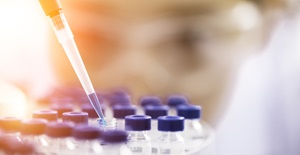Out-Law / Your Daily Need-To-Know
Out-Law Analysis 5 min. read
How a three-pronged IP strategy could help biosimilar manufacturers
23 Mar 2021, 2:34 pm
Biosimilars are medicinal products derived from biological sources. They are often large, complex molecules such as antibodies. Biosimilars are named as such because they are highly similar, but not identical, to originator biologic products.
The European biologics market has been steadily growing over the past decade and, according to a report published by health information technology company IQVIA, is now valued at €8.4 billion. There have been impressive innovations in the field from originator companies leading to this growth. The biosimilar share of that market has been increasing too over the last five years as more originator biologics have come "off-patent", i.e. their product patent protection expires.
A number of global blockbuster biologics are due to come off-patent over the next decade
The IQVIA report on the impact of biosimilar competition in Europe, produced at the request of the European Commission and published in December last year, shows biosimilars now account for 9% of the total European biologics market. Further, biosimilars have grown by approximate 60% year-on-year across the European biosimilars market over the past five years.
Interest in biosimilars has been increasing across Europe. This is because of their potential cost savings for public health authorities who may currently be limited in options where biologic manufacturers enjoy a monopoly. NHS England has estimated that biosimilar use on the NHS could deliver up to £300m a year in cost savings.
IQVIA said that the presence of biosimilar competition has caused the list price of medicines to fall by almost one third on average in the past decade. This has resulted in around a 5% reduction in drug budgets since 2014, with a further reduction of between 5% and 10% possible due to the impact that biosimilar competition could have on rebates and discounting practices.
Infliximab, which is used treat diseases such as rheumatoid arthritis and Crohn's disease, was the first monoclonal antibody biosimilar to reach European markets in 2015. Etanercept, rituximab, adalimumab and trastuzumab, which treat a range of autoimmune diseases and types of cancers, followed thereafter. Together these are among the most prominent examples of biologics that have come off-patent in recent years and are now subject to biosimilar competition in Europe. A number of other global blockbuster biologics, including cancer drugs Opdivo (nivolumab) and Keytruda (pembrolizumab), are due to come off-patent over the next decade. Further, 14 other high value loss of exclusivities are expected, which will change the biosimilar landscape from one which has been largely dominated by anti-TNF antibodies, to a diverse portfolio of products and opportunities.
As biosimilar manufacturers consider which products and markets to target, they will need to consider their intellectual property strategy. In parallel, biologic originators will need to consider their key markets, their patent portfolio and their appetite for licensing.
Navigating secondary patents
Biosimilar manufacturers should review the patent landscape for each of their biosimilar products a few years ahead of any launch. Even though primary product patents may be expiring, biologics may have secondary patents, or patent applications pending, covering new formulations, dosage regimes or new uses for the product, for example.
Biosimilar manufacturers should assess their likelihood of infringing the granted claims or the current claims pending before the European Patent Office. They can then consider potential design arounds, albeit with the restrictions of demonstrating that their product meets the regulatory requirements for biosimilarity, or consider challenging the validity of the patents in force. This may be achieved through opposition proceedings at the European Patent Office or through national litigation, which could also include an 'Arrow declaration' relating to pending patent applications.

Tracey Roberts
Partner
An Arrow declaration can give a biosimilar manufacturer commercial certainty at an early stage that it can proceed to launch a product without the risk of future infringement proceedings
An Arrow declaration is a discretionary remedy available from the courts of the UK and the Netherlands – and potentially other European countries. It sets out that a particular product or process was not new or was obvious at a specific point in time. The Arrow declaration therefore acts as a so-called 'Gillette' defence against claims of patent infringement, that the company is only practising something that was known or obvious before the patent.
Arrow declarations are of particular utility where a company has pending patent applications that, if granted, would read onto another company’s product or process. As invalidity or opposition proceedings are not permitted before a patent has been granted, an Arrow declaration can give a biosimilar manufacturer commercial certainty at an early stage that it can proceed to launch a product without the risk of future infringement proceedings. An Arrow declaration may also assist in defending infringement actions brought in other European countries, although must satisfy the test of having a 'useful purpose' in the UK.
Registering own IP rights
Biosimilar manufacturers should also consider filing their own patents for new technologies they have created during the development process, particularly relating to new formulations and medical devices, such as auto-injector pens. These rights may provide a valuable source of revenue through licensing. In that regard, biosimilar manufacturers are increasingly taking proactive steps to enforce their own patents with an increase in recent years in biosimilar-on-biosimilar litigation. This has been seen in Europe, with several cases being filed in relation to formulations of biosimilar adalimumab.
As a result of this developing practice, patent landscape searches should therefore look to other biosimilar competitors and not only originators for patents that could restrict their freedom to operate.
Licensing opportunities
Biosimilar manufacturers should also consider at what point they may want to approach an originator to discuss licensing, if at all.
Licensing at the outset offers biosimilars an opportunity to market their product without the risk of preliminary injunction proceedings, but biologics manufacturers may be unwilling to licence the use of their patents to potential rivals in the market.
A pan-European litigation strategy may provide useful leverage in any licensing negotiations in addition to potentially clearing the way launch in the event that a licence cannot be agreed.
Biologics may also seek wins in territories that they consider give the best chances of obtaining a preliminary injunction, for instance in Germany where invalidity proceedings may not be possible until the EPO opposition procedure has ended. That said, recent trends in the German courts indicate that preliminary injunctions should only be granted in respect of patents which have withstood opposition or first instance invalidity proceedings in Germany. A question on this practice was referred to the CJEU in January of this year.
Any litigation or opposition wins will strengthen each side's position if and when they come to the table to discuss the terms of a licence.
Outside factors may also influence the appetite to strike a deal. As a result of the Covid-19 pandemic, there are significant financial pressures on governments and health services globally. This fact may lead to tougher price negotiations with manufacturers and may also provide biosimilars with leverage in licensing negotiations with originators.
Whatever strategies are adopted, healthy competition between originators and biosimilars would be seen as a positive step in order to support a sustainable biosimilars market and improve access to these important medicines.

